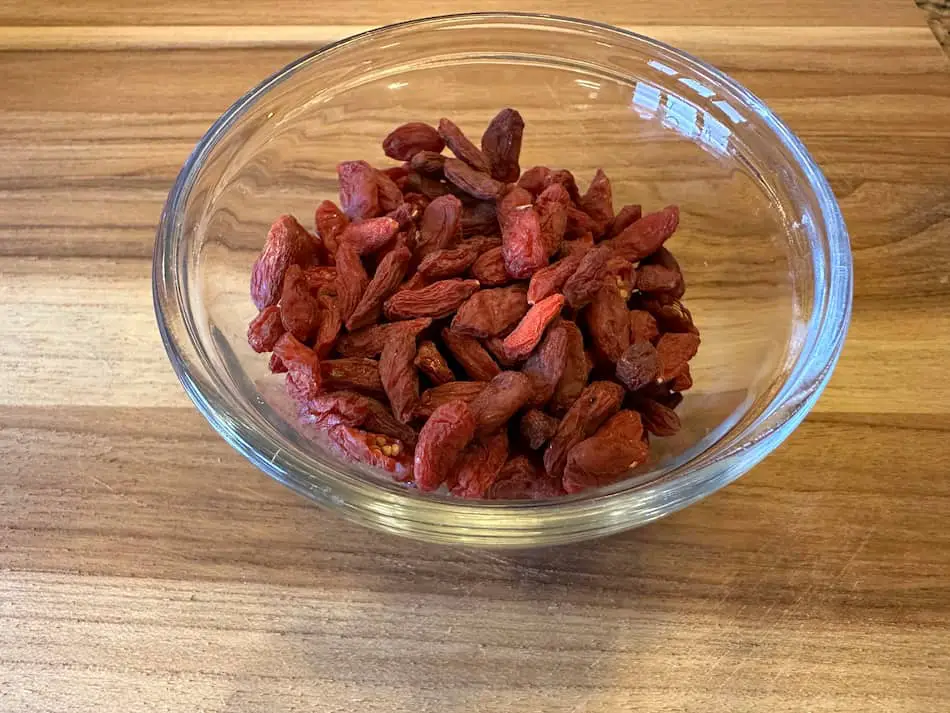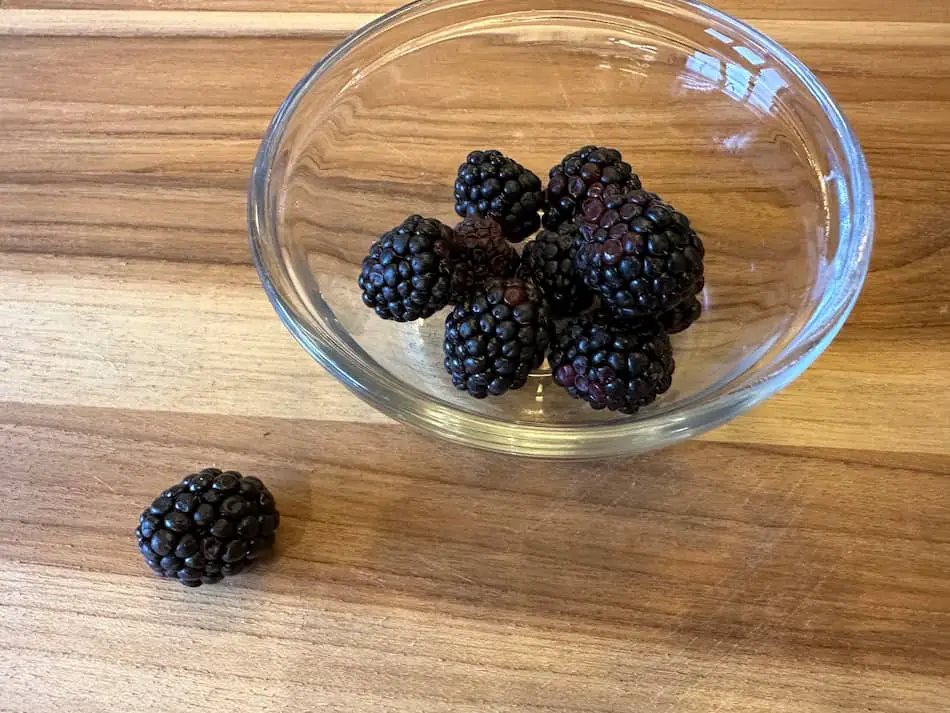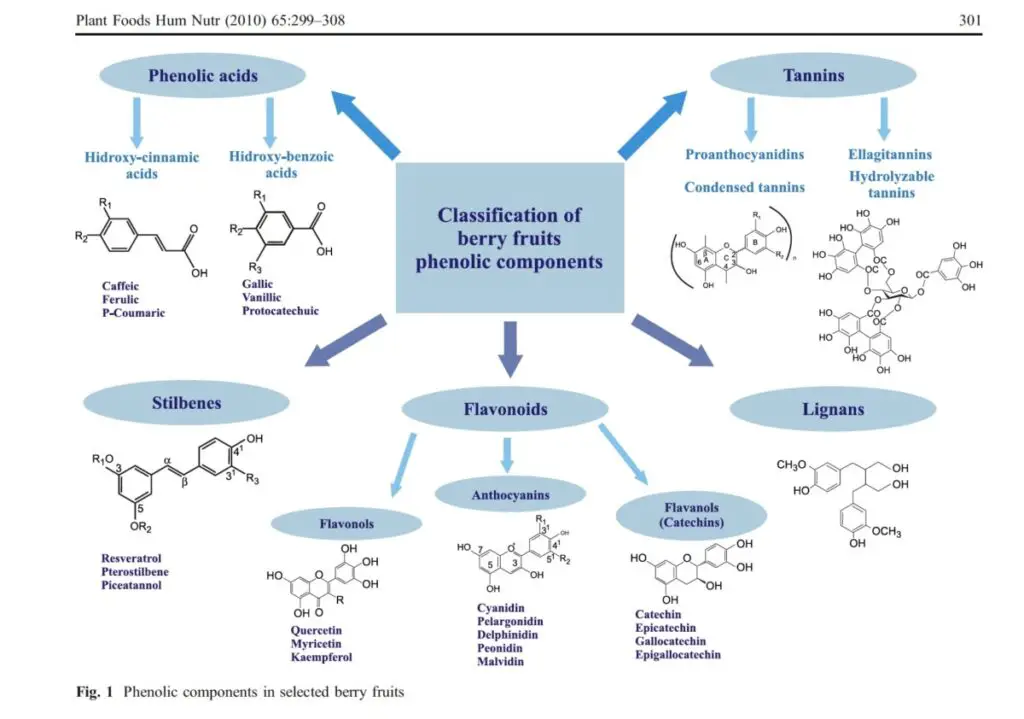
Berries are among the healthiest fruits you can eat. They are packed with vitamins, minerals, and phytonutrients, and often contain less sugar than other fruits. But which berry is the most nutritious?
Among 20 berry varieties tested, goji berries (dried) are among the most nutritious berries you will find. Goji berries are highest in fiber, calcium, iron, and have over 27 times the vitamin A as the berry with the second highest amount (which is acai)1. Goji berries are also surprisingly high in protein for a fruit, with 14.3 grams per serving (100 grams)–that’s 28% the DV for adults2 (buy my favorite organic brand on amazon here).
A downside of goji berries is that they are high in carbs. Even though they are the highest-fiber berry, they still have the highest net carb count. This, and their high nutritional status, could be because the data for them is based on the dried berries, which have more concentrated nutrition compared to fresh (not typically found in US grocery stores).
If the carbs in goji berries gives you pause, along with its relatively high price, let’s consider which berry is the healthiest among more readily-available, popular varieties.

Among the more widely available, popular berries, blackberries are overall the most nutritious. Compared to blueberries, raspberries and strawberries, blackberries are highest in antioxidants and lowest in net carbs. Blackberries are also highest in calcium, vitamin A, beta carotene, vitamin E, folate, and vitamin K.
See the detailed nutrition comparison charts below.
How This Data Presentation Is Unique
I have combined multiple resources into one reference chart. Many nutrition websites provide basic vitamin and mineral information, which most get from the USA FoodData Central. However, in my chart, I also include:
- Antioxidant data, which the USDA database does not provide. I show this information from two different sources, each of which used different methodologies to calculate their results. (Learn more about antioxidants here).
- I also calculated net carbs, a more helpful measure than carbohydrates alone, as it subtracts fiber, which is not absorbed during digestion. It’s more useful to monitor your net carbs than carbs alone (in general, high fiber foods do not need to be excluded from a low-carb diet).
Nutrition Comparison of Berries
Notes:
- Chart scrolls to right.
- Complete data for every berry is not available; however, missing information is mainly for the less commonly available berry types.
- A comparison chart of just the commonly available berries is further below.
| Per 100 grams | ORAC*3 units | Antioxidants4 mmol/100g | Calories | Net Carbs (fiber subtracted from carbs) (grams) | Fiber (grams) | Carbohydrates (grams) | Protein (grams) | Calcium (mg) | Iron (mg) | Magnesium (mg) | Potassium (mg) | Vitamin A (IU) | Beta Carotene (mg) | Vitamin C (mg) | Vitamin D (mg) | Vitamin E (alpha-tocopherol) (mg) | Folate (B-9) (µg) | Vitamin K (µg) | Lutein + Zeaxanthin (µg) |
| Acai (puree) | 102,700 | N/A | 60 | 3 | 3 | 6 | 2 | 40 | 1.08 | N/A | N/A | 1,000 | N/A | 9.6 | N/A | N/A | N/A | N/A | N/A |
| Bilberry | N/A | 7.57 | N/A | N/A | N/A | N/A | N/A | N/A | N/A | N/A | N/A | N/A | N/A | N/A | N/A | N/A | N/A | N/A | N/A |
| Blackberry | 5,905 | 4.02 | 43 | 4.31 | 5.3 | 9.61 | 1.39 | 29 | 0.62 | 20 | 162 | 214 | 128 | 21 | 0 | 1.17 | 25 | 19.8 | 118 |
| Blueberry (cultivated) | 4,669 | 1.85 | 57 | 12.1 | 2.4 | 14.5 | 0.74 | 6 | 0.28 | 6 | 77 | 54 | 32 | 9.7 | 0 | 0.57 | 6 | 19.3 | 80 |
| Blueberry (wild) | 9,621 | N/A | 61 | 9.7 | 2.6 | 12.3 | 1.22 | 13 | 0.37 | 7 | 75 | 115 | 69 | 18.3 | 0 | 1.69 | 33 | 17.2 | N/A |
| Boysenberry (frozen) | N/A | N/A | 50 | 6.9 | 5.3 | 12.2 | 1.1 | 27 | 0.85 | 16 | 139 | 67 | 40 | 3.1 | 0 | 0.87 | 63 | 7.8 | 118 |
| Chokeberry/Aronia5 | 16,062 | 13.48 | 47 | 4.3 | 5.3 | 9.6 | 1.4 | 30 | 1.4 | N/A | 105 | 350 | N/A | 21 | N/A | 1.6 | 24 | 13.6 | N/A |
| Cloudberry6 | 2,530 | 2.53 | 51 | 7.6 | 1.0 | 8.6 | 2.4 | 18 | 0.70 | 41 | 231 | N/A | N/A | 158 | N/A | 1.61 | 17 | 8.6 | N/A |
| Cranberry (raw) | 9,090 | 3.29 | 46 | 8.4 | 3.6 | 12 | 0.46 | 8 | 0.23 | 6 | 80 | 63 | 38 | 14 | 0 | 1.32 | 1 | 5 | 91 |
| Currant (black) | 7,957 | 5.49 | 63 | N/A | N/A | 15.4 | 1.4 | 55 | 1.54 | 24 | 322 | 230 | N/A | 181 | N/A | 1 | N/A | N/A | N/A |
| Currant (red) | 3,387 | 1.61 | 56 | 9.5 | 4.3 | 13.8 | 1.4 | 33 | 1 | 13 | 275 | 42 | 25 | 41 | 0 | 0.1 | 8 | 11 | 47 |
| Elderberry | 14,697 | 3.37 | 73 | 11.4 | 7 | 18.4 | 0.66 | 38 | 1.6 | 5 | 280 | 600 | N/A | 36 | N/A | N/A | 6 | N/A | N/A |
| Goji Berry/Wolfberry (dried) | 4,310 | 4.31 | 349 | 64.1 | 13 | 77.1 | 14.3 | 190 | 6.8 | N/A | N/A | 26,800 | N/A | 48.4 | N/A | N/A | N/A | N/A | N/A |
| Gooseberry/Amla | N/A | 1.45 | 44 | 5.9 | 4.3 | 10.2 | 0.88 | 25 | 0.31 | 10 | 198 | 290 | N/A | 27.7 | N/A | 0.37 | 6 | N/A | N/A |
| Huckleberry/Bilberry (dried) | 48,320 | 48.32 | 37 | N/A | N/A | 8.7 | 0.4 | 15 | 0.3 | N/A | N/A | 79 | N/A | 2.8 | N/A | N/A | N/A | N/A | N/A |
| Juneberry/Serviceberry/ Saskatoon | 15,000 | N/A | N/A | N/A | N/A | N/A | N/A | N/A | N/A | N/A | N/A | N/A | N/A | N/A | N/A | N/A | N/A | N/A | N/A |
| Lingonberry7 | 20,300 | N/A | 55 | 9.6 | 2.6 | 12.2 | 0.4 | N/A | N/A | N/A | N/A | N/A | N/A | N/A | N/A | N/A | N/A | N/A | N/A |
| Mulberry | N/A | N/A | 43 | 8.1 | 1.7 | 9.8 | 1.44 | 39 | 1.85 | 18 | 194 | 25 | 9 | 36.4 | 0 | 0.87 | 6 | 7.8 | 136 |
| Raspberry (red) | 5,065 | 2.33 | 52 | 18.4 | 6.5 | 11.9 | 1.2 | 25 | 0.69 | 22 | 151 | 33 | 12 | 26.2 | 0 | 0.87 | 21 | 7.8 | 136 |
| Strawberry | 4,302 | 2.16 | 32 | 5.68 | 2 | 7.68 | 0.67 | 16 | 0.41 | 13 | 153 | 12 | 7 | 58.8 | 0 | 0.29 | 24 | 2.2 | 26 |
Source: USDA FoodData, except where noted in footnotes.
*ORAC (Oxygen Radical Absorbance Capacity) is a method of measuring the antioxidant content in food.
Nutrition Comparison of Commonly Available Berries
Note: chart scrolls to the right.
| Per 100 grams (about 1 cup) | ORAC*1 units | Antioxidants2 mmol/100g | Calories | Net Carbs (fiber subtracted from carbs) (grams) | Fiber (grams) | Carbohydrates (grams) | Protein (grams) | Calcium (mg) | Iron (mg) | Magnesium (mg) | Potassium (mg) | Vitamin A (IU) | Beta Carotene (µg) | Vitamin C (mg) | Vitamin D (mg) | Vitamin E (alpha-tocopherol) (mg) | Folate (B-9) (µg) | Vitamin K (µg) | Lutein + Zeaxanthin (µg) |
| Blackberry | 5,905 | 4.02 | 43 | 4.31 | 5.3 | 9.61 | 1.39 | 29 | 0.62 | 20 | 162 | 214 | 128 | 21 | 0 | 1.17 | 25 | 19.8 | 118 |
| Blueberry (cultivated) | 4,669 | 1.85 | 57 | 12.1 | 2.4 | 14.5 | 0.74 | 6 | 0.28 | 6 | 77 | 54 | 32 | 9.7 | 0 | 0.57 | 6 | 19.3 | 80 |
| Raspberry (red) | 5,065 | 2.33 | 52 | 18.4 | 6.5 | 11.9 | 1.2 | 25 | 0.69 | 22 | 151 | 33 | 12 | 26.2 | 0 | 0.87 | 21 | 7.8 | 136 |
| Strawberry | 4,302 | 2.16 | 32 | 5.68 | 2 | 7.68 | 0.67 | 16 | 0.41 | 13 | 153 | 12 | 7 | 58.8 | 0 | 0.29 | 24 | 2.2 | 26 |
What is the Definition of a Berry?
The fruits in my charts are commonly thought of as berries and are eaten in similar ways as berries. However, they are not all technically berries. In botany, a berry is a simple fruit that comes from a single ovary of an individual flower. Blueberries and cranberries are true berries. Raspberries, blackberries and strawberries, however, are not. They are called aggregate fruits because each “berry” consists consists of a smaller number of fruits. And watermelons, cucumbers, and bananas, among many other fruits, are technically berries! So if you’re a botanist, forgive this list, but it’s based on more common usage of the term “berry.”
Why Are Berries So Good For You?
Berries are healthy not just because of their high vitamin, mineral and fiber content. Even more important may be their polyphenol content. Polyphenols are compounds that give plant foods their vibrant colors—the reds, yellow/oranges, blues purples—of flavonols (like quercetin); anthocyanins (like cyanidin); stilbenes (like resveratrol); and phenolic acids (like ferulic acid), among literally thousands of other polyphenol compounds. Here is a chart showing a family tree of polyphenols found in berries8:

Science is still learning how polyphenols help our health, but there is solid scientific evidence supporting their role in reduced disease and slower aging8.
Why Are Wild Blueberries Healthier Than Cultivated Blueberries?
Wild blueberries have higher levels of almost all the nutrients for which we have data. The higher nutrient content of wild blueberries is because these blueberries don’t have the aid of modern farming techniques like fertilizer and pesticides to protect them and help them grow. They have to use their own resources to thrive, so they have developed higher levels of nutrients like antioxidants, which help them ward off pests, diseases, radiation and other hazards. These substances benefit us in turn when we eat them.
Summing it Up
Many berries offer concentrated amounts of polyphenols compared to other fruits and vegetables. So eat them for their vitamins, minerals, and fiber, but also for their uniquely powerful polyphenol content. Among all berries, goji comes out on top for being highest in the most nutrients. Among more commonly available varieties, blackberry is the most nutritious.
If you liked this article, you might be interested in what the healthiest salad green is. Click here.
What’s the healthiest type of tea? Find out here.
Can you guess which fruit is highest in fiber? Answer is here.
References
3 https://superfoodly.com/orac-values/
4 The Antioxidant Food Table, Carlsen et al. 2010
5 https://nutritiondata.self.com/facts/custom/3081828/2
6 https://www.nutritionadvance.com/what-are-cloudberries/
7 https://www.nutritionadvance.com/types-of-berries/
8 Paredes-López, O., Cervantes-Ceja, M. L., Vigna-Pérez, M., & Hernández-Pérez, T. (2010). Berries: improving human health and healthy aging, and promoting quality life–a review. Plant foods for human nutrition (Dordrecht, Netherlands), 65(3), 299–308. https://doi.org/10.1007/s11130-010-0177-1.
9 Bertelli, A., Biagi, M., Corsini, M., Baini, G., Cappellucci, G., & Miraldi, E. (2021). Polyphenols: From Theory to Practice. Foods (Basel, Switzerland), 10(11), 2595. https://doi.org/10.3390/foods10112595.
